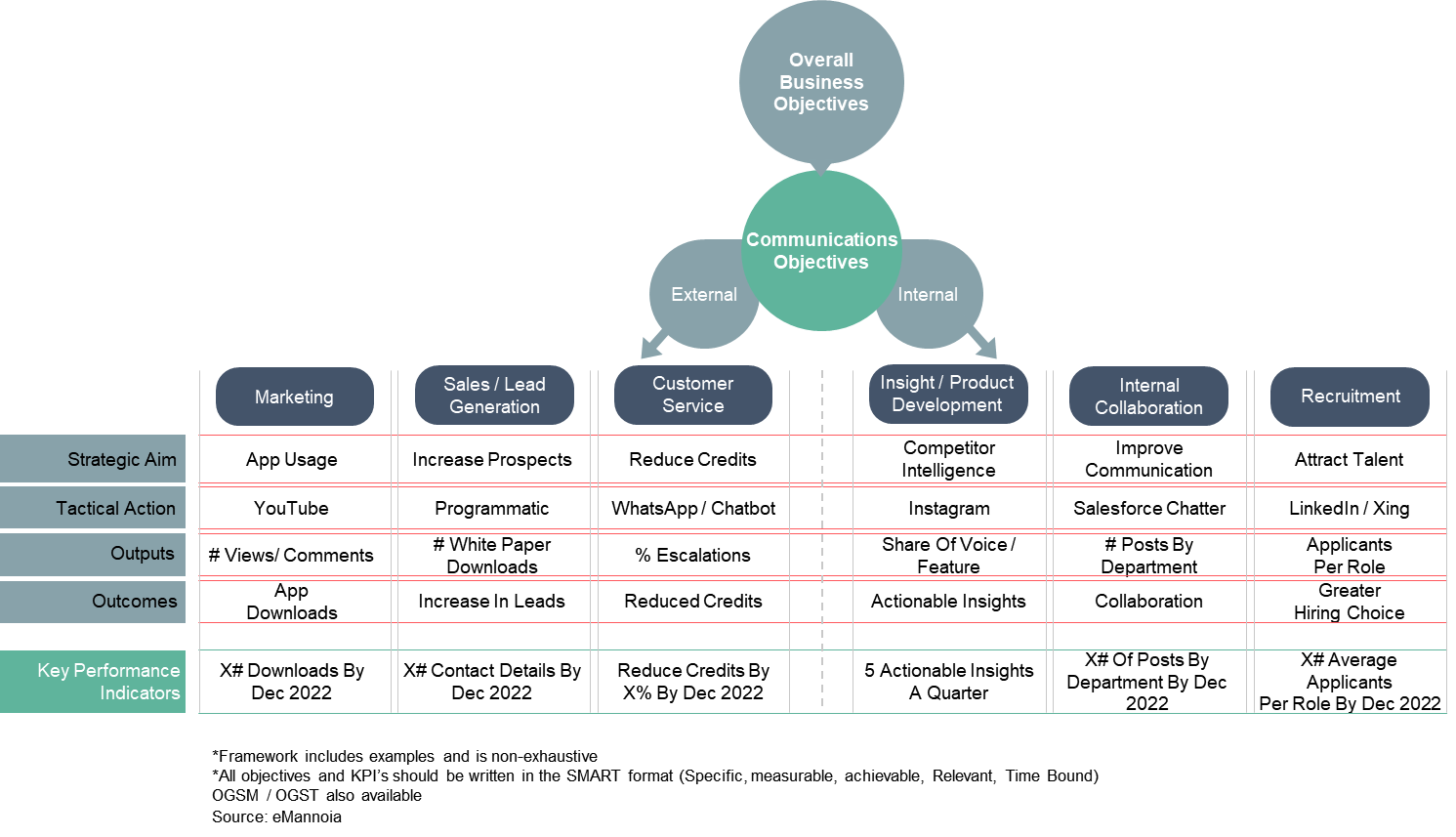A FRAMEWORK FOR STRATEGIC COMMUNICATIONS
by Eliot Mannoia // May 24, 2022
reading time: 3 minutes

© pexels / Ylanite Koppens
I am fortunate in that I get to spend a lot of time with clients on a daily basis. I have worked with 100+ clients in industries ranging from retail, e-commerce, automotive, FMCG, insurance, gaming, banking, sports, technology, entertainment etc. And an increasingly frequent topic of discussion at meetings is omnichannel communications strategy and measurement.
Below is a communications framework which I put together back in 2012, and it still serves its purpose well and ensures alignment across an organisation. The listed departments in blue are just examples.
Strategic Communications Framework

To ensure that all of the activities in a given organisation are aligned, one should always start at the top. What are the overall business objectives? Having these clearly stated, and communicated, will enable effective and efficient department communication strategies and subsequent tactics.
Usual Business Objectives
- Sales / Revenue
- Share price
- Market share
- EBITDA
- Net Promoter Score (NPS)
Once one or more of these objectives are determined it will guide your communications objectives. These should be closely linked to an organisation’s overall objectives and will thus avoid unnecessary campaigns (and budget) to win media awards, gain social media followers or any other vanity metrics of “success”.
Usual Communication Objectives:
- Drive awareness
- Generate leads
- Convert to sales
- Increase sign-ups, registrations, app downloads etc.
- Post-purchase marketing (e.g. reviews, referrals)
- Crisis and reputation management
- New product development (e.g. testing, trends)
Using the agreed upon communication objectives you then set succinct strategic aims for each department, along with the various tactics. These tactics will of course be a mix of generating awareness (upper funnel) and driving action (lower funnel) activities.
We then turn our attention to metrics. The difference between outputs and outcomes may appear subtle, but is crucial for effective measurement. Outputs are metrics like impressions, engagement, clicks, likes etc. They do not speak to the ultimately desired outcome. For example impressions is just a proxy metric for awareness. For actual awareness measurement one must employ a brand tracker / brand lift study. Similarly clicks do not necessarily mean traffic. I’ve had a client that had ~100,000 clicks, but actually only ~50,000 page visits. Outputs serve as secondary metrics, the outcome should be the primary metric. The primary metric forms the key performance indicator (KPI).
Here an example framework filled in:

As you can see the KPI is linked with outcome, which is derived from the strategic aim. It should all connect all the way up to the business objectives.
Where possible, utilising metrics which the wider business utilizes such as sales, Net Promoter Scores (NPS), market share, footfall, return on investment (ROI) etc. will streamline reporting up to senior management and make it more effective.
A holistic measurement solution should capture both quantitative and qualitative results, utilising campaign tools, onsite analytics, research and ideally sales figures. That’s when you can go beyond measuring simple outputs, and look at actual outcomes. This is when you can prove a return on investment (ROI). Or did a given campaign cause a surge in sign-ups, museum visits or, if you are a charity, volunteers – is there a correlation? Omnichannel campaigns are more prevalent these days, so for a more sophisticated analysis of contribution one can also use econometric modelling. Besides correlation analysis and econometric modelling, market research is another tool which can determine behavioural shifts, changes in net promoter score (NPS) and general awareness. Again, always link results back to business objectives.
I have seen communications strategies unaligned with the overarching businesses goals, and doing so may well work from time to time, but it can jeopardise the longevity and perceived performance of an activity/campaign. I would strongly recommend to start at the top, the business objectives, and then work your way down.
Also keep a keen eye on the absence of data and the corresponding insight derived from that, and conversely, do not simply measure data that is readily available but perhaps not relevant. Once you have the results and look to interpret them remember – not what, but so what and now what?
How do you demonstrate ROI in your communications initiatives? What intelligence do you gather? Want to talk strategy?
Drop us a line, we would love to hear from you!
#brandkarma #digitalpsychologist #strategicommunication #strategy #communication #framework
